AFFF Thyroid Disease Lawsuit
- Last Updated: June 12th, 2025

Attorney Jessica Paluch-Hoerman, founder of TruLaw, has over 28 years of experience as a personal injury and mass tort attorney, and previously worked as an international tax attorney at Deloitte. Jessie collaborates with attorneys nationwide — enabling her to share reliable, up-to-date legal information with our readers.
Legally Reviewed
This article has been written and reviewed for legal accuracy and clarity by the team of writers and legal experts at TruLaw and is as accurate as possible. This content should not be taken as legal advice from an attorney. If you would like to learn more about our owner and experienced injury lawyer, Jessie Paluch, you can do so here.
Fact-Checked
TruLaw does everything possible to make sure the information in this article is up to date and accurate. If you need specific legal advice about your case, contact us by using the chat on the bottom of this page. This article should not be taken as advice from an attorney.
Key takeaways:
- Exposure to AFFF firefighting foam can lead to thyroid diseases due to toxic PFAS chemicals.
- Victims file lawsuits against manufacturers for not warning about the health risks of AFFF.
- Evidence like medical records and expert testimony is needed to establish causation in court.
Overview of the AFFF Thyroid Disease Lawsuit
On this page, we’ll provide an overview of the AFFF Thyroid Disease Lawsuit, estimates for possible AFFF lawsuit settlement amounts, eligibility criteria to file an AFFF lawsuit, and much more.
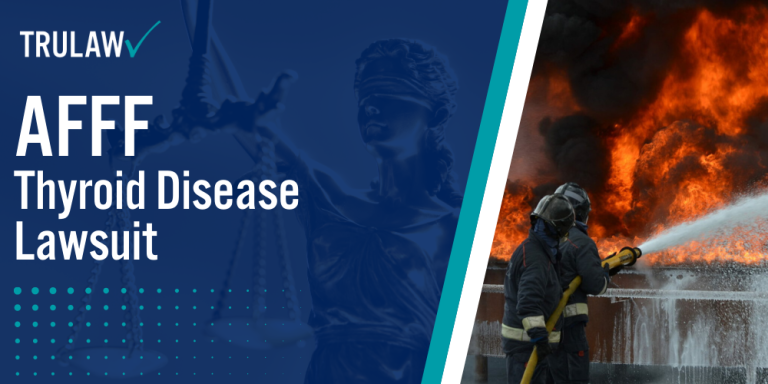
What is the AFFF Thyroid Disease Lawsuit?
Since the 1960s, Aqueous Film Forming Foam (AFFF) has been used, especially by the U.S. military, to suppress highly flammable liquid fires.
AFFF contains PFAS chemicals, commonly known as “forever chemicals,” which have been associated with significant health risks, such as thyroid diseases, thyroid cancer, and several other types of cancer.
While the use of AFFF has largely been phased out, many individuals continue to suffer from health conditions potentially linked to PFAS exposure.
AFFF firefighting foam lawsuits are being filed nationwide by individuals who have experienced health issues related to this exposure, such as thyroid disease.
If you or a loved one has been diagnosed with thyroid disease, cancer, or other related health concerns, you may be eligible to pursue legal action.
You can use the chatbot on this page to see if you qualify to file an AFFF lawsuit instantly.
Our team is available to answer any questions you may have about your potential claim.
If you believe you may have been affected by AFFF exposure, don’t hesitate to reach out for more information.
Table of Contents
Connection Between AFFF Firefighting Foam and Thyroid Disease
Both civilian and military firefighters have extensively used AFFF foam to combat fires involving highly flammable liquids.
However, despite its firefighting efficiency, AFFF contains PFAS chemicals, which have been associated with a heightened risk of thyroid disease.
The connection between PFAS exposure and thyroid disease is well-established.
Multiple studies have demonstrated a link between these toxic chemicals and disruptions in thyroid function.
For example, a 2018 meta-analysis found a consistent pattern of decreased thyroid hormone levels in individuals exposed to PFAS.
A 2020 review also highlighted the thyroid-disrupting effects of both older and newer PFAS chemicals, identifying pregnant women and developing children as particularly vulnerable groups.
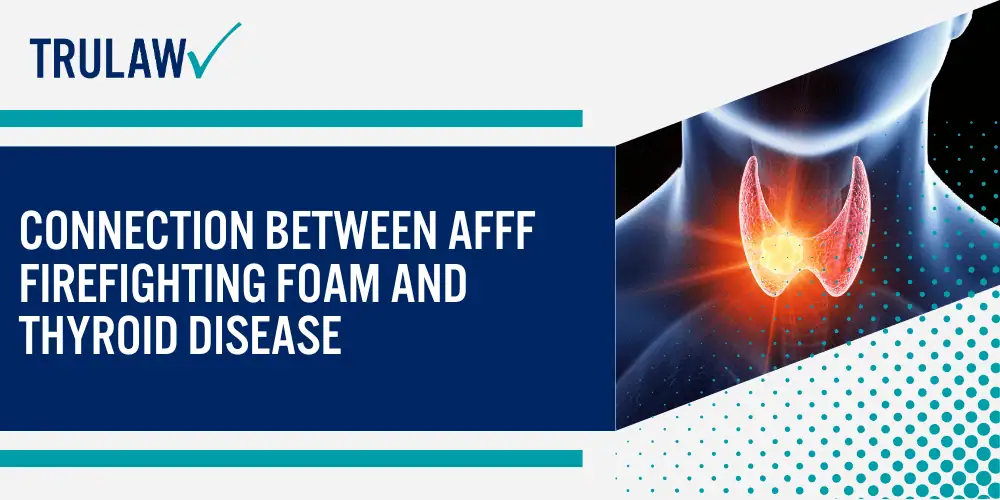
The Environmental Protection Agency (EPA) has identified children and industrial workers as two (2) of the most vulnerable groups to PFAS exposure.
Military firefighters, in particular, have faced elevated exposure due to their frequent use of AFFF in training and real-world fire suppression.
Impact of PFAS Chemicals in Firefighting Foam on Human Health
Research indicates that both the U.S. Navy and chemical manufacturers were aware of the toxic effects of PFAS chemicals in AFFF long before official warnings were issued.
The Environmental Protection Agency and U.S. Department of Defense have since acknowledged the serious health risks associated with AFFF exposure, including thyroid disease and cancer.
Numerous studies have demonstrated the dangers of PFAS chemicals, which are present in AFFF firefighting foam.
The health impacts extend across a range of populations, including firefighters, chemical plant workers, and individuals in related industries who may have come into contact with the foam.
Studies on the links between AFFF exposure and health risks include:
- Research published in the Journal of the American Medical Association identified a link between PFOA exposure and a higher risk of developing kidney cancer, testicular cancer, and ulcerative colitis.
- The International Agency for Research on Cancer (IARC) has categorized PFOA as a possible carcinogen and PFOS as potentially carcinogenic to humans.
- The U.S. Environmental Protection Agency (EPA) has released a health advisory for PFOA and PFOS, cautioning that prolonged exposure to these chemicals could lead to serious health risks.
- Research conducted by the National Research Centre for Environmental Toxicology (Australia) revealed that firefighters are likely to have increased levels of fluorinated surfactants in their bloodstream.
- Researchers at the University of California, Berkeley found that women firefighters who used AFFF foam had higher levels of PFAS in their bodies than those who did not.
- Research in the International Journal of Cancer found a link between PFOS exposure and breast cancer.
Health Risks Linked to Aqueous Film-Forming Foam (AFFF) Exposure
AFFF exposure has been linked to numerous health conditions, particularly cancers and other chronic health issues.
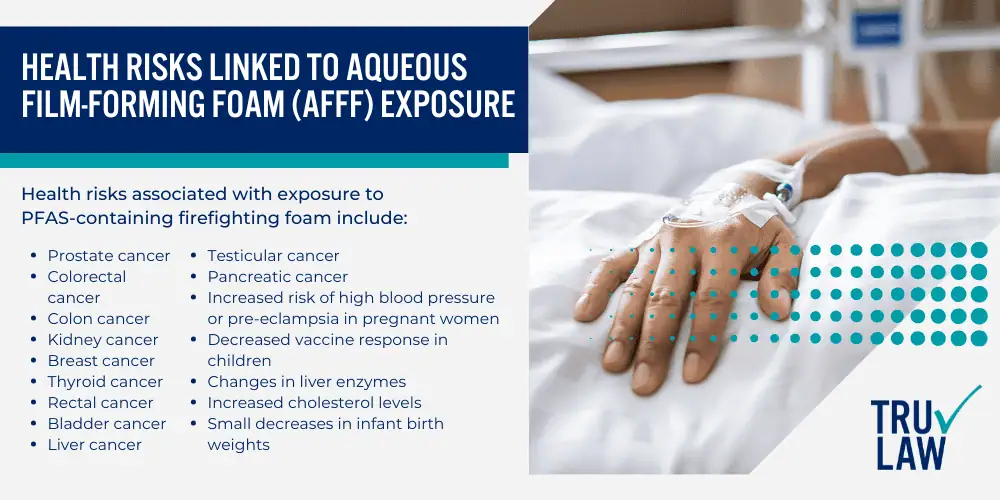
Health risks associated with exposure to PFAS-containing firefighting foam include:
- Prostate cancer
- Colorectal cancer
- Colon cancer
- Kidney cancer
- Breast cancer
- Thyroid cancer
- Rectal cancer
- Bladder cancer
- Liver cancer
- Testicular cancer
- Pancreatic cancer
- Increased risk of high blood pressure or pre-eclampsia in pregnant women
- Decreased vaccine response in children
- Changes in liver enzymes
- Increased cholesterol levels
- Small decreases in infant birth weights
These health risks underscore the importance of staying informed about potential AFFF exposure and understanding the legal options available to those who may have been impacted.
What You Need to Know About the AFFF Firefighting Foam Lawsuit
The AFFF lawsuits involve a series of claims filed by individuals exposed to PFAS chemicals found in toxic firefighting foam.
These plaintiffs include a variety of individuals, such as military firefighters who served at U.S. military installations, airport workers, civilian firefighters, industrial workers, and others.
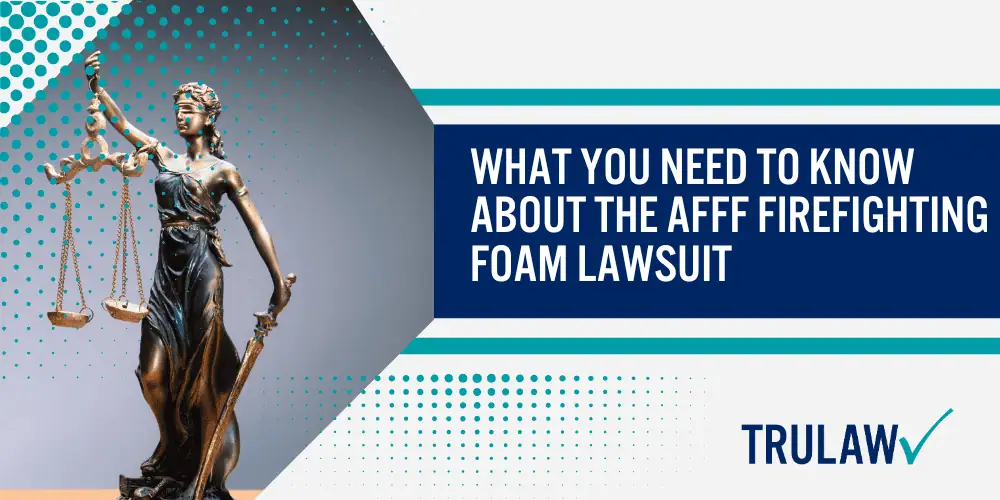
Plaintiffs are pursuing legal action against manufacturers of AFFF, claiming that exposure to PFAS chemicals in firefighting foam has led to serious health issues.
Given the high volume of AFFF firefighting foam cases, the litigation has been consolidated into a multidistrict litigation (MDL).
This AFFF firefighting foam MDL is being managed in the U.S. District Court for the District of South Carolina under MDL 2873.
Who Are the Defendants in AFFF Firefighting Foam Cases?
The defendants in the AFFF lawsuits include several manufacturers responsible for producing and supplying AFFF products to military bases, airports, and other facilities.
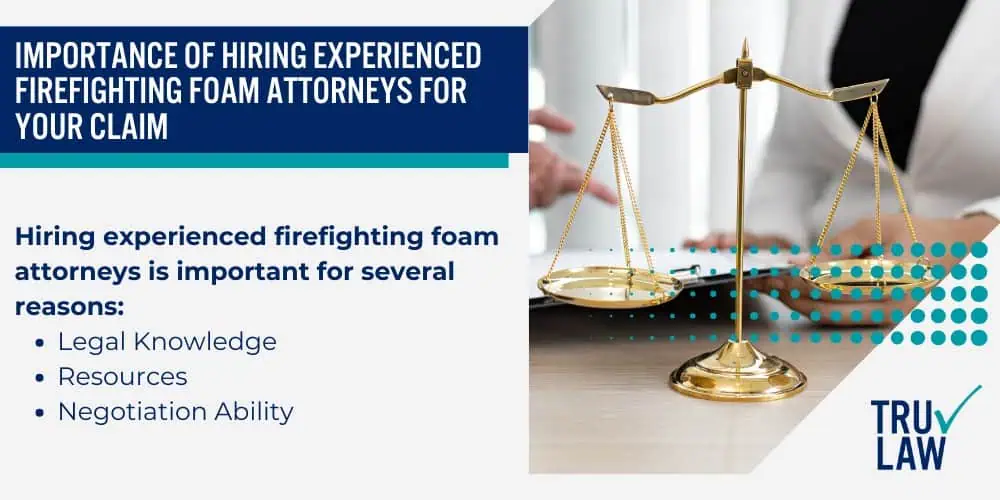
Current defendants in the AFFF lawsuits include:
- Arkema Inc.
- Chubb National Foam Inc.
- Clariant Corp.
- 3M
- Kidde-Fenwal
- Carrier Global Corp.
- AGC Chemicals Americas
- BASF Corp.
- Tyco Fire Products
- DuPont
- Corteva Inc.
- Dynax Corp.
- UTC Fire & Security Americas
- Chemours
As the litigation continues, additional manufacturers may be named as defendants as more individuals come forward with personal injury claims.
The outcome of these lawsuits will determine whether plaintiffs will receive settlements for their AFFF exposure-related health conditions.
Estimated Settlement Amounts for AFFF Lawsuits
Although the AFFF lawsuits are ongoing, no settlement has been awarded at this time.
However, based on past MDL cases involving product liability, we estimate potential settlement amounts for successful AFFF claims could range from $20,000 to $600,000 (or more).
These figures are projections based on previous mass tort cases and are not guaranteed outcomes.
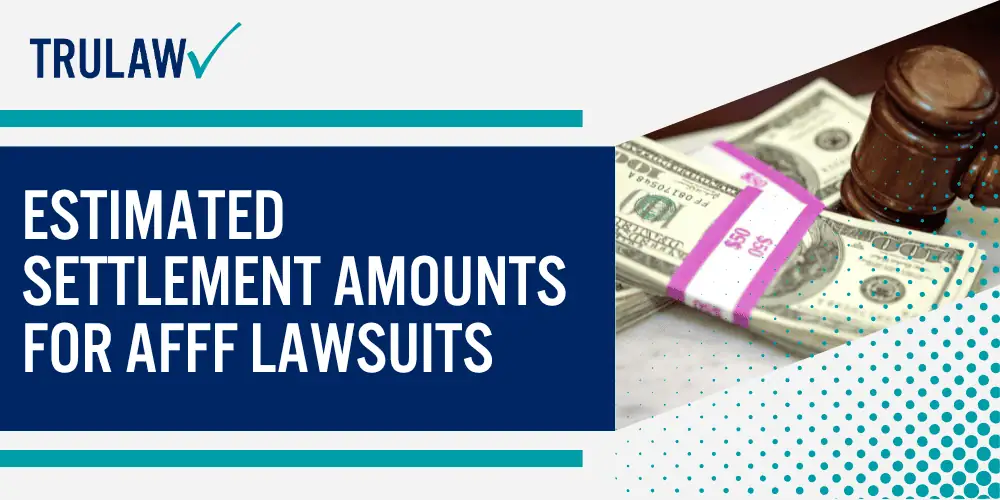
The amount you may recover will depend on specific factors in your case, including your exposure to AFFF and the illnesses you have developed.
For more information on potential AFFF lawsuit settlement amounts, visit this page.
How to File an AFFF Thyroid Disease Lawsuit
If you or a loved one has developed thyroid disease due to exposure to AFFF foam, you may be eligible to pursue legal action alongside others affected by this harmful substance.
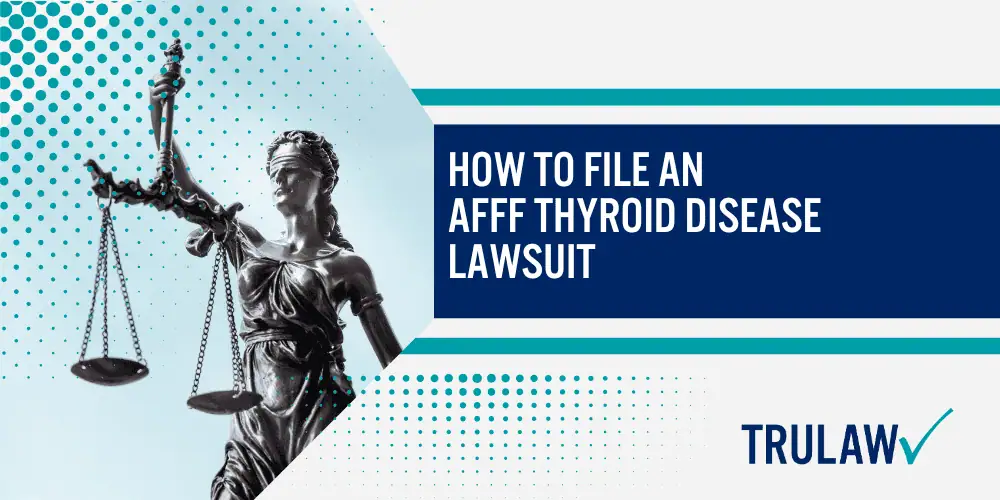
Finding out whether you qualify for a claim is an important first step.
You can use the chatbot on this page for an instant eligibility check regarding AFFF lawsuits.
The experienced firefighting foam lawyers at TruLaw and our partner law firms are here to provide the support needed to build a strong case for you — including assisting with gathering evidence and evaluating damages.
Steps for Gathering Evidence in AFFF Lawsuits
Gathering the right evidence is important to build a compelling case for an AFFF firefighting foam lawsuit.
While you can begin collecting information on your own, having legal guidance helps ensure nothing important is overlooked.
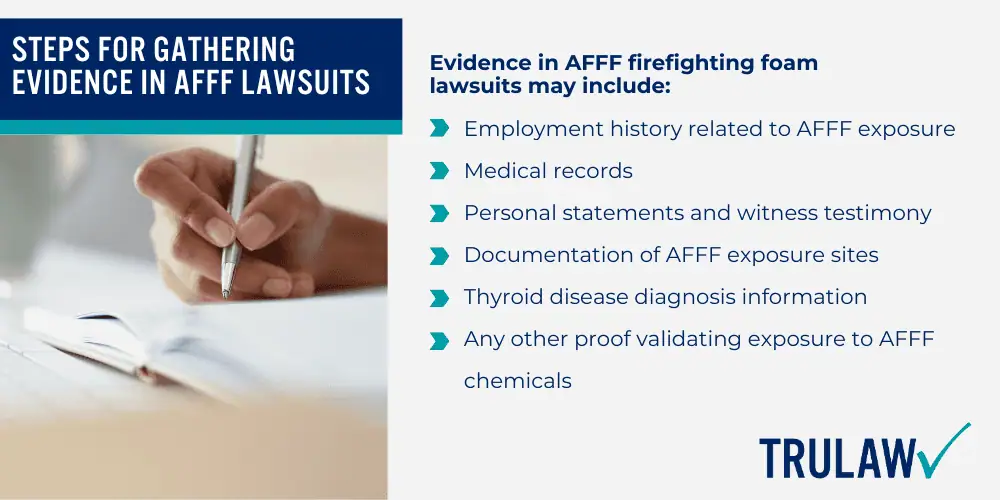
Evidence in AFFF firefighting foam lawsuits may include:
- Employment history related to AFFF exposure
- Medical records
- Personal statements and witness testimony
- Documentation of AFFF exposure sites
- Thyroid disease diagnosis information
- Any other proof validating exposure to AFFF chemicals
Damages in AFFF Firefighting Foam Lawsuits
When assessing damages for an AFFF thyroid disease lawsuit, it’s important to account for all the losses you’ve experienced as a result of your diagnosis.
These can include both economic and non-economic damages, all of which need careful calculation to pursue the compensation you deserve.
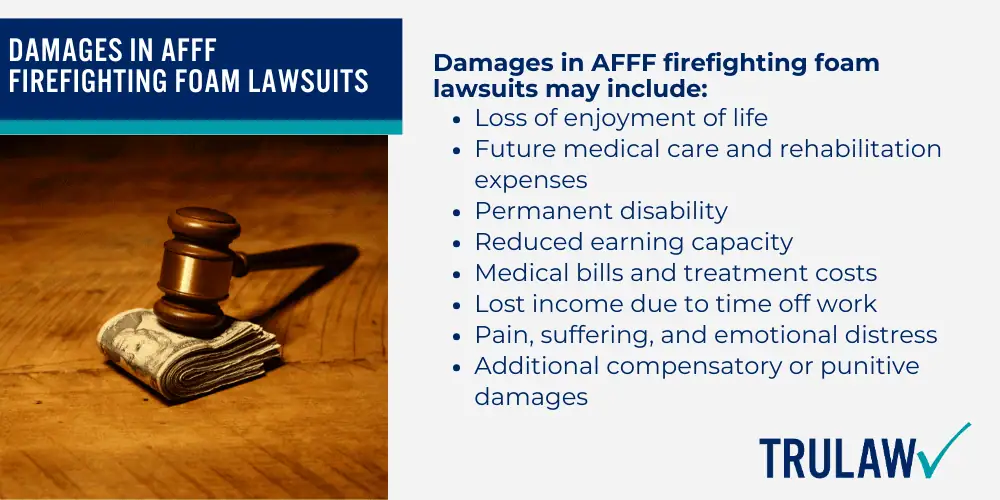
Damages in AFFF firefighting foam lawsuits may include:
- Loss of enjoyment of life
- Future medical care and rehabilitation expenses
- Permanent disability
- Reduced earning capacity
- Medical bills and treatment costs
- Lost income due to time off work
- Pain, suffering, and emotional distress
- Additional compensatory or punitive damages
If you have lost a loved one due to health issues caused by toxic firefighting foam, additional damages may include:
- Funeral expenses
- Loss of consortium
- Punitive damages
- Grief counseling and therapy costs
Why Hiring Experienced Firefighting Foam Attorneys for Your Claim Is Important
Seeking compensation from manufacturers of AFFF foam is a challenging process, and it’s not something you should undertake alone.
Having the right legal team ensures your interests are represented and that your rights are protected throughout the lawsuit.
The AFFF lawyers at TruLaw and our partner law firms work tirelessly to help establish liability and hold those responsible for AFFF exposure accountable for your health issues.
Together, we bring our experience in product liability and mass tort claims to your case, ensuring your losses are carefully evaluated and pursued.
With our support, you can focus on your health while we help you seek fair compensation for everything you’ve endured.
TruLaw: Your Firefighting Foam Cancer Law Firm
The experienced firefighting foam lawyers at TruLaw and our partner law firms are here to support individuals seeking legal action related to AFFF exposure.
Firefighting foam containing PFAS chemicals has been linked to serious health risks, including cancer, and lawsuits are being pursued nationwide to hold corporations accountable.
If you or a loved one has developed cancer or experienced other adverse health effects after regular exposure to firefighting foam, you may qualify to file an AFFF lawsuit and seek compensation.
Contact us today for more information.
You can use the chatbot on this page to instantly see if you qualify to file an AFFF lawsuit.
AFFF exposure has been connected to a range of health risks, including cancer and other serious conditions.
We believe those impacted by these chemicals deserve to be heard, and our team is ready to help provide you with the legal resources and support you need.
AFFF Lawsuit Frequently Asked Questions
-
What is the average AFFF lawsuit settlement?
A successful AFFF firefighting foam lawsuit will require thorough information, such as evidence of exposure, medical records, and supporting documentation for the claim.
These factors may play a role in determining an appropriate settlement amount for each individual case.
Although no settlements have been reached in the AFFF litigation thus far, attorneys predict that potential settlement amounts could range from $20,000 and $600,000 (or more), depending on the strength of each case and other contributing factors.
These figures are not guarantees but are projections based on prior mass tort cases involving cancer diagnoses and exposure to harmful substances.
-
Is there an AFFF class action lawsuit?
No, there isn’t currently an AFFF class action lawsuit for individuals suffering from health issues related to AFFF exposure.
Instead, AFFF lawsuits are consolidated into multidistrict litigation (MDL), which allows cases with similar claims to be handled together more efficiently.
The AFFF MDL is centralized in the US District Court for the District of South Carolina, where pending and current AFFF lawsuits are being processed.
Some law firms might use the terms “AFFF Class Action Lawsuit” or “AFFF Class Action MDL,” but these descriptions are inaccurate.
The current legal process is an AFFF multidistrict litigation, not a class action.
-
What cities and governments have filed AFFF lawsuits for water contamination?
In addition to individual lawsuits, several local and state governments have filed lawsuits against AFFF manufacturers, holding them responsible for water contamination caused by the chemicals.
The following jurisdictions and localities have taken legal action against AFFF manufacturers:
- La Crosse, WI
- Peshtigo, WI
- Baltimore, MD
- Thornton, CO
- Philadelphia, PA
- Fairbanks, AK
- Pittsboro, NC
- State of Michigan
- State of New Hampshire
- State of Massachusetts
- State of Ohio
- State of Vermont
Additionally, various water agencies have also initiated lawsuits against AFFF manufacturers to address contamination concerns.
It’s important to note that TruLaw is only accepting clients with AFFF personal injury claims — we are not accepting clients for the AFFF municipal water contamination lawsuits.
-
What are the signs of Thyroid Disease?
The symptoms of thyroid disease can vary depending on whether the thyroid is overactive (hyperthyroidism) or underactive (hypothyroidism).
Here are the symptoms associated with each condition:
Hyperthyroidism (Overactive Thyroid):
- Nervousness and Anxiety
- Tremors
- Eye Changes (Graves’ Disease)
- Weight Loss
- Sleep Disturbances
- Heat Sensitivity
- Muscle Weakness
- Fatigue
- Increased Heart Rate
- Changes in Bowel Habits
Hypothyroidism (Underactive Thyroid):
- Depression
- Menstrual Irregularities
- Elevated Cholesterol
- Cold Intolerance
- Memory and Cognitive Issues
- Weight Gain
- Muscle and Joint Pain
- Hoarseness
- Fatigue
- Constipation
- Dry Skin and Hair
- Swelling
Recognizing these symptoms early is important for seeking medical evaluation and treatment for thyroid disease.

Managing Attorney & Owner
With over 25 years of legal experience, Jessica Paluch-Hoerman is an Illinois lawyer, a CPA, and a mother of three. She spent the first decade of her career working as an international tax attorney at Deloitte.
In 2009, Jessie co-founded her own law firm with her husband – which has scaled to over 30 employees since its conception.
In 2016, Jessie founded TruLaw, which allows her to collaborate with attorneys and legal experts across the United States on a daily basis. This hypervaluable network of experts is what enables her to share the most reliable, accurate, and up-to-date legal information with our readers!
Additional AFFF Lawsuit resources on our website:
Here, at TruLaw, we’re committed to helping victims get the justice they deserve.
Alongside our partner law firms, we have successfully collected over $3 Billion in verdicts and settlements on behalf of injured individuals.
Would you like our help?
At TruLaw, we fiercely combat corporations that endanger individuals’ well-being. If you’ve suffered injuries and believe these well-funded entities should be held accountable, we’re here for you.
With TruLaw, you gain access to successful and seasoned lawyers who maximize your chances of success. Our lawyers invest in you—they do not receive a dime until your lawsuit reaches a successful resolution!
AFFF Lawsuit claims are being filed against manufacturers of aqueous film-forming foam (AFFF), commonly used in firefighting.
Claims allege that companies such as 3M, DuPont, and Tyco Fire Products failed to adequately warn users about the potential dangers of AFFF exposure — including increased risks of various cancers and diseases.
Depo Provera Lawsuit claims are being filed by individuals who allege they developed meningioma (a type of brain tumor) after receiving Depo-Provera birth control injections.
A 2024 study found that women using Depo-Provera for at least 1 year are five times more likely to develop meningioma brain tumors compared to those not using the drug.
Suboxone Tooth Decay Lawsuit claims are being filed against Indivior, the manufacturer of Suboxone, a medication used to treat opioid addiction.
Claims allege that Indivior failed to adequately warn users about the potential dangers of severe tooth decay and dental injuries associated with Suboxone’s sublingual film version.
Social Media Harm Lawsuits are being filed against social media companies for allegedly causing mental health issues in children and teens.
Claims allege that companies like Meta, Google, ByteDance, and Snap designed addictive platforms that led to anxiety, depression, and other mental health issues without adequately warning users or parents.
Transvaginal Mesh Lawsuits are being filed against manufacturers of transvaginal mesh products used to treat pelvic organ prolapse (POP) and stress urinary incontinence (SUI).
Claims allege that companies like Ethicon, C.R. Bard, and Boston Scientific failed to adequately warn about potential dangers — including erosion, pain, and infection.
Bair Hugger Warming Blanket Lawsuits involve claims against 3M — alleging their surgical warming blankets caused severe infections and complications (particularly in hip and knee replacement surgeries).
Plaintiffs claim 3M failed to warn about potential risks — despite knowing about increased risk of deep joint infections since 2011.
Baby Formula NEC Lawsuit claims are being filed against manufacturers of cow’s milk-based baby formula products.
Claims allege that companies like Abbott Laboratories (Similac) and Mead Johnson & Company (Enfamil) failed to warn about the increased risk of necrotizing enterocolitis (NEC) in premature infants.
Here, at TruLaw, we’re committed to helping victims get the justice they deserve.
Alongside our partner law firms, we have successfully collected over $3 Billion in verdicts and settlements on behalf of injured individuals.
Would you like our help?
